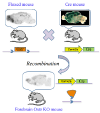Using transgenic mouse models to study oxytocin's role in the facilitation of species propagation
- PMID: 20732312
- PMCID: PMC2992605
- DOI: 10.1016/j.brainres.2010.08.042
Using transgenic mouse models to study oxytocin's role in the facilitation of species propagation
Abstract
Oxytocin and its receptor are important for a wide range of effects, from social memory to uterine contractions. It is an evolutionarily well-conserved hormone that is particularly important in social and gregarious animals. Research on small mammals has yielded a rich literature on oxytocin's many functions. Recently a new tool has been created that has furthered our understanding of oxytocin's role in behavior: transgenic mice that lack either the ability to synthesize oxytocin or the oxytocin receptor itself. The study of these lines, while still in its infancy, is already bearing fruit and offers the promise of insight into some human disorders characterized by aberrant social behavior.
Published by Elsevier B.V.
Figures

Similar articles
-
Gene targeting approaches to neuroendocrinology: oxytocin, maternal behavior, and affiliation.Horm Behav. 1997 Jun;31(3):221-31. doi: 10.1006/hbeh.1997.1377. Horm Behav. 1997. PMID: 9213136 Review.
-
New aspects of oxytocin receptor function revealed by knockout mice: sociosexual behaviour and control of energy balance.Prog Brain Res. 2008;170:79-90. doi: 10.1016/S0079-6123(08)00408-1. Prog Brain Res. 2008. PMID: 18655874 Review.
-
Oxytocin: the great facilitator of life.Prog Neurobiol. 2009 Jun;88(2):127-51. doi: 10.1016/j.pneurobio.2009.04.001. Epub 2009 Apr 10. Prog Neurobiol. 2009. PMID: 19482229 Free PMC article. Review.
-
Regulatory mechanisms of oxytocin-mediated sociosexual behavior.Ann N Y Acad Sci. 1997 Jan 15;807:287-301. doi: 10.1111/j.1749-6632.1997.tb51927.x. Ann N Y Acad Sci. 1997. PMID: 9071358 Review. No abstract available.
-
Isotocin increases female avoidance of males in a coercive mating system: Assessing the social salience hypothesis of oxytocin in a fish species.Horm Behav. 2019 Jun;112:1-9. doi: 10.1016/j.yhbeh.2019.03.001. Epub 2019 Mar 23. Horm Behav. 2019. PMID: 30902535
Cited by
-
Social housing conditions and oxytocin and vasopressin receptors contribute to ethanol conditioned social preference in female mice.Physiol Behav. 2015 Nov 1;151:469-77. doi: 10.1016/j.physbeh.2015.08.018. Epub 2015 Aug 15. Physiol Behav. 2015. PMID: 26282397 Free PMC article.
-
Oxytocin receptor knockout mice display deficits in the expression of autism-related behaviors.Horm Behav. 2012 Mar;61(3):436-44. doi: 10.1016/j.yhbeh.2011.10.010. Epub 2011 Nov 9. Horm Behav. 2012. PMID: 22100185 Free PMC article.
-
Is birth a critical period in the pathogenesis of autism spectrum disorders?Nat Rev Neurosci. 2015 Aug;16(8):498-505. doi: 10.1038/nrn3956. Epub 2015 Jul 8. Nat Rev Neurosci. 2015. PMID: 26152864 Review.
-
Oxytocin, Erectile Function and Sexual Behavior: Last Discoveries and Possible Advances.Int J Mol Sci. 2021 Sep 26;22(19):10376. doi: 10.3390/ijms221910376. Int J Mol Sci. 2021. PMID: 34638719 Free PMC article. Review.
-
Implications of Oxytocin in Human Linguistic Cognition: From Genome to Phenome.Front Neurosci. 2016 Jun 14;10:271. doi: 10.3389/fnins.2016.00271. eCollection 2016. Front Neurosci. 2016. PMID: 27378840 Free PMC article.
References
-
- Acher R, Chauvet J, Chauvet MT. Man and the chimaera. Selective versus neutral oxytocin evolution. Advances in Experimental Medicine and Biology. 1995;395:615–627. - PubMed
-
- Agmo A, Choleris E, Kavaliers M, Pfaff DW, Ogawa S. Social and sexual incentive properties of estrogen receptor alpha, estrogen receptor beta, or oxytocin knockout mice. Genes Brain Behav. 2008;7:70–77. - PubMed
-
- Amico JA, Mantella RC, Vollmer RR, Li X. Anxiety and stress responses in female oxytocin deficient mice. J Neuroendocrinol. 2004;16:319–324. - PubMed
-
- Amico JA, Vollmer RR, Cai HM, Miedlar JA, Rinaman L. Enhanced initial and sustained intake of sucrose solution in mice with an oxytocin gene deletion. Am J Physiol Regul Integr Comp Physiol. 2005;289:R1798–R1806. - PubMed
-
- Argiolas A, Melis MR, Vargiu L, Gessa GL. d(CH2)5Tyr(Me)-[Orn8]vasotocin, a potent oxytocin antagonist, antagonizes penile erection and yawning induced by oxytocin and apomorphine, but not by ACTH-(1–24) European Journal of Pharmacology. 1987;134:221–224. - PubMed
Publication types
MeSH terms
Substances
Grants and funding
LinkOut - more resources
Full Text Sources

